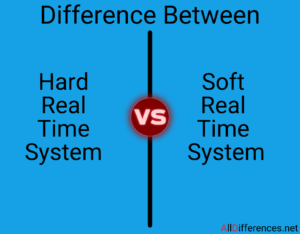Difference Between Hard and Soft Real Time System in Tabular Form
Contents
- The Major Difference Between Hard and Soft Real Time System is that Real Time Operating Systems specify by having time as a key parameter. Real time operating system has well defined fixed time constraints. Processing must be done within defined constraints or the system will fail.
- Types of Real Time Operating System
- Hard real-time system
- Soft real time system
- An example of real-time system is e-Cos.

Comparison Chart
| Hard real time | Soft real time |
|---|---|
| Hard response time is required. | Soft response time is required. |
| Data integrity is short term. | Data integrity is long term. |
| Size of the data file is small or medium. | Size of the data file is large. |
| Peak load performance is predictable. | Peak load performance is degraded. |
| Hard real-time systems have little laxity and generally provide full deadline compliance. | Soft real-time systems are more flexible. They have greater laxity and can tolerate certain amounts of deadline misses. |
| Safety critical systems are typically a hard real time system. | Linux and many OS provide a soft real time system. |
Hard Real time system
- This system guarantees that critical tasks complete on time.
- Many of these are found in industrial process control, avionics, and military and similar application areas.
- This goal says that all delays in the system must be restricted.
- These systems must provide absolute guarantees that a certain action will occur by a certain time.
- Examples
- Chemical and nuclear plant control
- Autopilot System In Plane
- Pacemakers
Soft Real-Time System
- In this type of system, missing an occasional deadline, while not desirable, is acceptable and does not cause any permanent damage.
- Digital audio, digital telephone, and multimedia systems fall into this category.
- Examples
- Mobile Communication
- Music Playing Robots
- Weather Station
